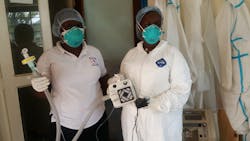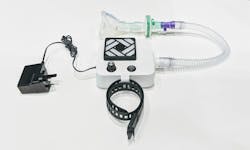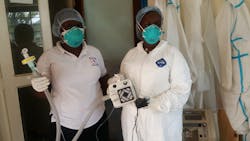At a Glance:
- The CPAP ventilation system is built around a simple electric fan and is intended to offset equipment shortages in low to middle income countries.
- The breathing device for COVID patients is based on the principles of frugal engineering.
- Selco India’s solar lamp, which lasts up to nine hours after charging, is another example of the creative problem-solving approach.
Caught off-guard by COVID-19, communities struggled over the past year to respond with limited resources.
Then the world marveled at the resourceful ways in which engineering and medical communities were able to either improvise or bend existing technologies to create new tools. Thanks to principles such as frugal innovation, we can safely say the level of inventiveness was anything but stunted—even in resource-constrained healthcare environments.
Frugal innovation or frugal engineering is typically associated with reducing the complexity and cost of a product or solution for low-resource communities. Successful examples over the past year have ranged from protective gear (using overhead transparencies and a hole punch to create to make protective shields) to respirators (using 3D printed valves to transform snorkeling masks into emergency CPAP masks to help patients breathe).
In a paper published Aug. 24 in the journal Frontiers in Medical Technology, researchers describe a continuous positive airway pressure or CPAP device that can help patients struggling to breathe due to moderate or severe COVID-19.
The CPAP ventilation system (known as the LeVe system) is built around a simple electric fan and is intended to offset equipment shortages in low- to middle-income countries. The breathing aid uses air flow dynamics of electric fan blowers, as they deliver positive pressure at appropriate flow rates for CPAP, noted the authors. The system achieved results that were equivalent to commercially available CPAP systems.
Doing More with Less, for More People
“By adopting the approach of frugal innovation, we have been able to redesign an important piece of medical equipment so it can function effectively in poorer-resourced healthcare settings,” said Nikil Kapur, professor of Applied Fluid Dynamics at the University of Leeds and the supervising academic on the project. “We have stripped away unnecessary complexity and ensured the device will work in settings where oxygen supplies are scarce and need to be conserved. The prototype is an important step in developing a device that will create greater access to critical-care technology and help save lives.”
The prototype has been specifically made to work with oxygen concentrators, which have a low flow of oxygen and at low pressure, said Peter Culmer, associate professor in the School of Mechanical Engineering at Leeds.
The fan or CPAP blower is connected to a breathing circuit, explained Culmer. “That circuit is made up of a filter to catch viruses and bacteria in the air flow, tubing, face mask, a valve which controls the flow of oxygen from the oxygen concentrator, and an expiration outlet,” he said.
The fan system provides a safe air flow supply without needing more complex control systems or a high-pressure air source. The researchers explained that the system can generate an airflow sufficient to open the patient’s airways, so oxygen can get into the tiny air sacs in the lungs, without risk of adverse effects. The oxygen concentrator is used to enrich this airflow with oxygen, conserving valuable supplies, they said.
The device is composed of relatively simple technology, which will improve access in low- and middle-income countries, according to the interdisciplinary team from University of Leeds, Leeds Teaching Hospitals NHS Trust, Bradford Teaching Hospitals NHS Foundation Trust, Medical Aid International and the Mengo Hospital in Uganda.
Components for the protype cost around $207. Conventional CPAP machines can range from $250 to $1,000. Ventilators used in intensive care units can run between $25,000 and $50,000.
A landmark U.K. trial demonstrated that treating hospitalized COVID-19 patients who have acute respiratory failure with CPAP reduces the need for invasive mechanical ventilation.
More Than Good Enough
Frugal design principles—also called jugaad—are most commonly used in situations where environmental factors such as the lack of electricity or water may pose barriers. Rather than view these factors as a limitation or drawback, the constraint is viewed as an opportunity to innovate in a way that creates value for the community.
A prominent example is Selco India’s solar lamp, which lasts up to nine hours after charging. The solution was made possible by Harish Hande, co-founder of the social energy enterprise, who pioneered the delivery of decentralized and affordable solar energy to underserved areas of India.
Of necessity, governments, healthcare agencies, academia and industry alike have over the past year collaborated to support research that will spur innovators to find affordable solutions. The National Institutes of Health, for example, has invested in a multitude of wide-ranging collaborative efforts spanning the development of vaccines and diagnostic strategies for safe and effective treatments of COVID-19. The NIH invested $1.5 billion in the Rapid Acceleration of Diagnostics (RADx) program.
In one example, Stanford’s bioengineering researchers, led by Manu Prakash, combined a hand-powered centrifuge with a low-cost assay to detect Sars-CoV-2 in saliva samples. The Handyfuge is based on a flashlight toy and aims to bring the scale of testing to the layperson, reported Prakash, whose main research focus is to figure out how to make cost-effective solutions for medical problems. The hand-powered centrifuge is electricity free for resource-constrained settings, noted Prakash’s Twitter feed (@PrakashLab), which published detailed instructions for building the device.
About the Author

Rehana Begg
Editor-in-Chief, Machine Design
As Machine Design’s content lead, Rehana Begg is tasked with elevating the voice of the design and multi-disciplinary engineer in the face of digital transformation and engineering innovation. Begg has more than 24 years of editorial experience and has spent the past decade in the trenches of industrial manufacturing, focusing on new technologies, manufacturing innovation and business. Her B2B career has taken her from corporate boardrooms to plant floors and underground mining stopes, covering everything from automation & IIoT, robotics, mechanical design and additive manufacturing to plant operations, maintenance, reliability and continuous improvement. Begg holds an MBA, a Master of Journalism degree, and a BA (Hons.) in Political Science. She is committed to lifelong learning and feeds her passion for innovation in publishing, transparent science and clear communication by attending relevant conferences and seminars/workshops.
Follow Rehana Begg via the following social media handles:
X: @rehanabegg
LinkedIn: @rehanabegg and @MachineDesign


